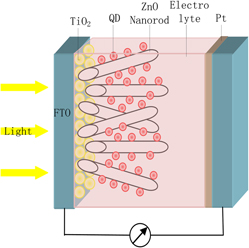Article contents
Application of hydrothermally synthesized zinc oxide nanorods in quantum dots-sensitized solar cells
Published online by Cambridge University Press: 04 March 2013
Abstract

Zinc oxide (ZnO) nanomaterial is a superior material for photoanode. However, the different reaction concentrations, growth time and reaction vessel have influences on the structure and morphology of ZnO, and and ultimately have a bearing on the performance of solar cells. In this article, we used the hydrothermal method for the preparation of ZnO nanostructure. For avoiding direct contact of electrolyte with fluorine-doped tin oxide conducting glass, and decrease the recombination probabilities, we used titanium tetrachloride pretreatment. For obtaining flower-like ZnO nanostructure that was composed of smaller diameter ZnO nanorods, we fabricated a smaller-particle seed layer prior to growing ZnO nanostructure. For the sake of getting the best performances of solar cells, we examined the various effects of different deposition cycles on the performance of the solar cells. We discovered that when the deposition cycles increased, short-circuit current density, open-circuit voltage, fill factor and conversion efficiency all increased. But when the deposition exceeded 9 cycles, the values of all the parameters decreased. When the deposition cycle is 9, the conversion efficiency is 1.156%.
- Type
- Articles
- Information
- Copyright
- Copyright © Materials Research Society 2013
References
REFERENCES
- 1
- Cited by


